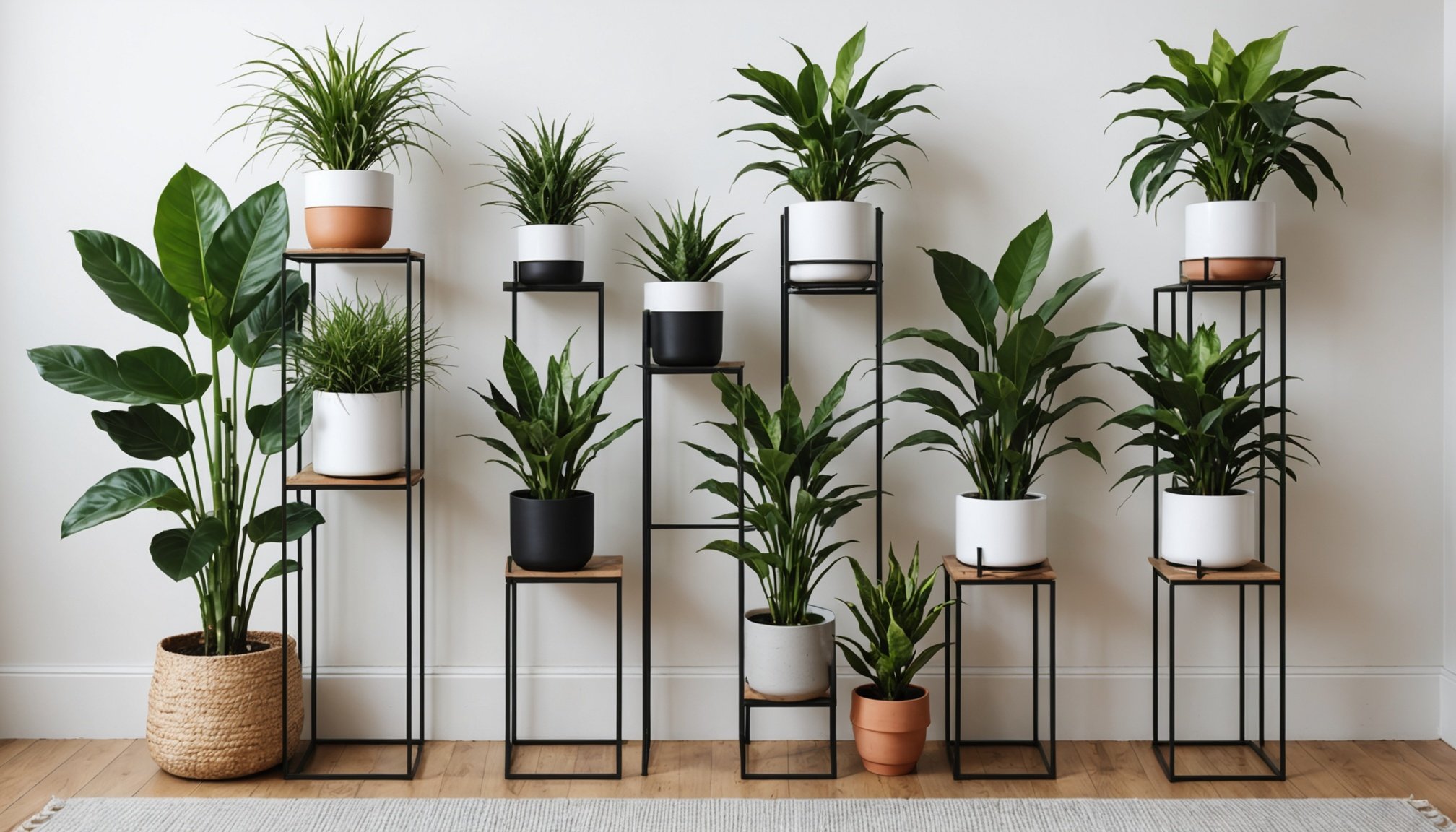Inspiration for Multi-Tiered Indoor Plant Stands
Exploring the world of multi-tiered plant stands unveils a charming marriage between practicality and aesthetics, particularly in minimalist decor. The principle of minimalist design is about clarity and simplicity, achieving beauty through less clutter and more serene spaces.
A well-designed multi-tiered plant stand exemplifies this by providing vertical solutions that save space while offering a clean display of greenery. Picture sleek metal or wooden stands, their frames simple yet elegant, holding an array of vibrant indoor plants in a corner of your lounge. This not only enhances your indoor gardening experience but elevates your interior decor to a new level of sophistication.
Also read : Discover the Best Smart Lighting Solutions for Your Home Automation System
Integrating plants into minimalist spaces offers numerous advantages. Plants naturally purify air and introduce a gentle, calming presence that complements the clean lines and neutral tones typical of minimalist design. They create visual interest and can be focal points, breathing life into static spaces through simple arrangements.
Embodying these principles, a multi-tiered plant stand allows for diverse plant displays while maintaining order and design clarity. They are versatile enough to fit stylishly into various settings from living rooms to home offices, making them an ideal choice for enthusiasts of both indoor gardening and contemporary aesthetics.
Also read : Creating an Eco-Friendly Gym: Innovative Energy-Generating Workout Equipment for Sustainable Fitness
DIY Options for Crafting Your Own Plant Stand
Creating your own DIY plant stand is a rewarding endeavor that combines creativity with functionality. With the right approach and materials, you can tailor a plant stand that fits your aesthetic and space requirements.
Choosing the Right Materials
Selecting the appropriate crafting materials is a crucial first step. Opt for sustainable options like reclaimed wood or bamboo, which are both eco-friendly and stylish. Metal pipes can be an industrial-chic choice, while repurposed items like old crates add a rustic touch. Ensure materials are durable to support the weight of multiple plants if you’re crafting a multi-tiered stand.
Step-by-Step Building Process
Begin your project by sketching a design that suits your space. Cut your chosen crafting materials to size, ensuring precision for a balanced structure. Assemble the base securely before moving on to successive tiers. Use screws or nails to hold the stand together, reinforcing the joints for stability. This meticulous approach guarantees that your DIY plant stand is both functional and aesthetically pleasing.
Finishing Touches and Personalization
Once assembled, consider painting or staining the stand to blend with your decor. A minimalist aesthetic often favors neutral or natural hues, but feel free to add a splash of color to express your personality. Incorporate personal touches like decorative knobs or engraved designs to make your DIY plant stand truly unique.
Selecting Suitable Plants for Your Stand
Choosing the right indoor plants can transform your multi-tiered stand into a thriving green display. Knowing which species thrive indoors is essential to create an appealing and sustainable garden within your home.
Best Indoor Plants for Multi-Tiered Stands
Suitable species for indoor environments often include those that are resilient and require minimal light. Spider plants, pothos, and peace lilies are popular choices due to their adaptability and low maintenance needs. These plants not only survive but flourish in varying light conditions, making them ideal for multi-tiered displays.
Tips for Plant Selection
Visual appeal can be enhanced by mixing different leaf textures and colours. Consider plants with trailing vines for the top tiers, creating a cascading effect. Place bushier plants on the bottom to balance out the arrangement. This creative synergy brings your plant stand to life with layers of visual interest.
Basic Plant Care Guidelines
Proper plant care is vital for maintaining healthy indoor plants. Ensure each plant gets the appropriate amount of water—overwatering is a common mistake. Regularly dust plant leaves to allow for unobstructed photosynthesis, promoting robust growth. By following these guidelines, your indoor plants will thrive and remain visually stunning on their multi-tiered stand.
Integrating Plant Stands into Existing Interiors
Crafting an appealing interior design while efficiently using space can be a balancing act. Plant stands offer a practical solution, effortlessly merging aesthetic with utility in any room.
Placement for Optimal Aesthetics
Positioning plant stands wisely can elevate your space. Depending on your interior design style, consider strategically placing stands near windows for natural light. This enhances the visual appeal while ensuring plants thrive. For cohesiveness, match the stand’s material with existing furniture, such as wood or metal.
Creating a Focal Point in Your Room
Using plants as statement pieces can transform minimalist layouts into engaging spaces. Position your plant stands as a central feature. Choose vibrant plants or large foliage to create a striking contrast against neutral backgrounds. This approach serves not only as an eye-catcher but also amplifies the room’s theme.
Multi-Tiered Stands in Small Spaces
In compact areas, multi-tiered stands maximize space utilization. These stands allow different plant arrangements without overwhelming the room. Opt for staggered designs to maintain an open feel, showcasing each plant uniquely. Clever placement, such as corners or alongside furniture, ensures functionality remains intact while boosting decor.
Additional Design Considerations
Incorporating design aesthetics into plant stand selection can transform an ordinary room into a harmonious living space. When choosing a plant stand for interiors with minimalist aesthetics, consider color palettes that match the clean lines and neutral tones typical of such environments. Neutral shades like whites, greys, and muted pastels blend seamlessly, enhancing the overall design without overwhelming the space.
Balancing practicality and style is essential in plant stand designs. While it is important to select a stand that complements your interior style, consider its functionality as well. This includes the stand’s ability to support the plant’s weight, accommodate different pot sizes, and provide adequate drainage. A beautifully designed stand that fails to serve its practical purpose can diminish the intended aesthetic value.
Furthermore, the importance of texture and form should not be underestimated in enhancing aesthetic appeal. Varying textures like smooth metal, rough wood, or polished ceramic add depth and interest to a room. Meanwhile, modern geometric shapes or classic curves can introduce a dynamic or soothing focal point. By meticulously balancing color, texture, and form, a plant stand can elevate the ambiance of your living space.











